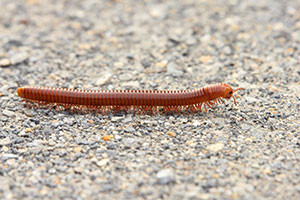First, it is important to point out the similarities that these two types of arthropods have. For instance, they are both from the group Myriapoda. They also both have segmented bodies, numerous legs, and breath through spiracles, which are openings on the surface of their bodies that lead to their respiratory systems. While the two species are from the same group in the animal kingdom, it’s important to note that there are more than 13,000 species within the group Myriapoda, with an almost infinite amount of variation between them.
Centipedes are further classified into the class of Chilopoda, while millipedes are placed into the class of Diplopoda. Species in the class of Chilopoda are flexible and have flattened appearances, while those in the class of Diplopoda are more rigid and sub-cylindrical in shape. It’s also important to note here that neither centipedes nor millipedes are insects, though they are often mistakenly referred to as such. Insects are classified as only have three pairs of legs, one pair on each segment, while both centipedes and millipedes have many segments, with one or two pairs of legs on each, respectively. There is also no set number of legs with centipedes and millipedes, and there will usually be a lot of variation between specific species of each.
You’ve probably seen both centipedes and millipedes inside your home at some point, especially if you live in Florida, where both are considered to be household pests. You probably find millipedes to be far more innocent than centipedes, however, as they are incredibly slow moving and generally harmless. Their legs are also not visible unless you get very close to them, they are not capable of biting, and they feed only on decaying organic matter. While understandably a nuisance inside your home, these creatures are considered a very ecologically important part of the environment.
Centipedes, on the other hand, are a different story. Even while having fewer legs than millipedes, they are incredibly fast movers, a fact which is accentuated by the fact that their legs veer off from the sides of their bodies and trail backwards and are highly visible in comparison to the legs of millipedes. Centipedes also have to be handled carefully because they bite, releasing a venom into their prey which in rare cases can cause allergic reactions in humans.
You may think you’ve seen enough of these critters in your houses but we promise, both centipedes and millipedes are a lot more interesting in the Everglades, where on an airboat ride you run the chance of spotting a few alongside alligators, snakes, and birds in every color of the rainbow. Don’t miss your chance to experience the Florida Everglades on a safe, yet thrilling airboat tour today.







